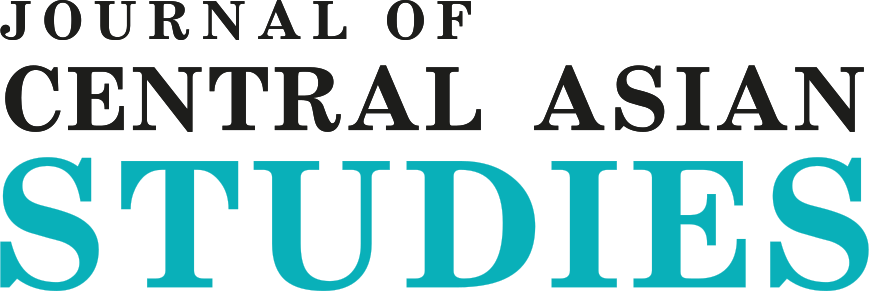Проблемы религиозного экстремизма и терроризма в Центральной Азии: обзор радикальных групп
DOI:
https://doi.org/10.52536/3006-807X.2024-4.004Ключевые слова:
религиозный экстремизм, терроризм, безопасность, ИГИЛ, террористические группировки, центральноазиатские боевики, институционализация, риски, радикализацияАннотация
В январе 2019 года США объявили о победе над террористической организацией «Исламское государство» (далее – ИГИЛ). Тем самым была проведена промежуточная черта в многолетней международной борьбе с ИГИЛ. Однако зоны нестабильности продолжают широко привлекать радикальные группировки. Сегодня они действуют в сирийской провинции Идлибе, Ливане, Мали, Нигерии. В свою очередь в 2021 году в Афганистане к власти пришли талибы, серьезно изменив статус-кво в большом регионе Центральная Азия+. В октябре 2023 года началась военная операция в Газе, что также привело в движение различные террористические организации и указало на глобальный идеологический разлом. В контексте происходящих событий в Сирии и Афганистане, которые в последнее десятилетие стали центром так называемого «глобального джихада», важный научный интерес представляют потенциальные угрозы и риски, исходящие от террористических и экстремистских организаций из Центральной Азии.
Целью данной статьи является анализ деятельности основных радикальных групп с выходцами из Центральной Азии. Интерес вызван, прежде всего, тем фактом, что в Сирии и Афганистане произошел активный процесс институционализации группировок центральноазиатских боевиков. Это привело к появлению новых объединений. В рамках научной работы были рассмотрены условия распространения религиозного экстремизма, а также представлена хронология становления радикальных групп Казахстана и Узбекистана, и их место в общей архитектуре региональной безопасности. Новизной в статье выступает оценка имеющихся тенденций, которые позволяют предполагать, что религиозный экстремизм и терроризм станут одним из главных факторов дестабилизации ситуации в регионе Центральная Азия.
Способность стран Центральной Азии к мобилизации своих внутренних возможностей преодолевать имеющиеся угрозы серьезно влияет на проекцию будущих перспектив Центральной Азии как безопасного, конкурентоспособного и развитого региона.
Библиографические ссылки
Anti-Terrorist Center of CIS Member States. (2016). The State Committee for National Security of Kyrgyzstan identified the organizers and perpetrators of the attack on the Chinese Embassy in Kyrgyzstan. CIS ATC. https://www.cisatc.org/news/8500
Burke, J. (2024). Islamic State recruiting from Tajikistan and other Central Asian countries. Retrieved from “The Guardian”, 2024 March 24 https://www.theguardian.com/world/2024/mar/24/islamic-state-recruitingmilitants-from-tajikistan-and-other-central-asian-countries
Federal Security Service of the Russian Federation. (2024). The FSB of Russia, in cooperation with Rosfinmonitoring and the Investigative Committee, eliminated an international resource channel for the "Katiba Tawhid wal-Jihad" terrorist group. FSB Press Center. http:// www.fsb.ru/fsb/press/message/single.htm%21id%3D10439924%40fsbMessage.html
Global Terrorism Index (2024). IEP (Institute for Economics and Peace), p. 72-73. https://www.economicsandpeace.org/wp-content/uploads/2024/02/GTI-2024-web-290224.pdf
Hill, F. (2003). Central Asia: Terrorism, religious extremism, and regional stability. Testimony before the House Committee on International Relations, Subcommittee on the Middle East and Central Asia. Retrieved from The Brookings Institution. https://www.brookings.edu/wp-content/uploads/2016/06/20030723-1.pdf
"Islamic Jihad Union": A portrait of a terrorist organization. (2016). Retrieved from Anti-Terror Today. https://antiterrortoday.com/baza-dannykh/terroristicheskie-i-ekstremistskie-gruppirovki/soyuz-islamskogodzhikhada-gruppa-islamskogo-dzhikhada/386-soyuz-islamskogo-dzhikhada-portret-terroristicheskojorganizatsii
The Islamic Movement of Uzbekistan swears allegiance to ISIS. (2015). Retrieved from the Uzbek Service of Radio Free Europe/Radio Liberty. https://rus.ozodi.org/a/27175205.html
Islamists from Central Asia charged in Germany. (2024). Retrieved from Deutsche Welle. https://www.dw.com/ru/v-frg-predavili-obvinenia-islamistam-iz-centralnoj-azii/a-68910952
The "Jaish-ul-Mahdi" case gains new details. (2016). Retrieved from News-Asia. http://www.news-asia.ru/view/9134
Karin, E., & Zenn, J. (2017). Between ISIS and al-Qaeda: Central Asian militants in the Syrian war. Astana Stratcom Team.
Komar, R., Borys, C., & Woods, E. (2017). The Blackwater of Jihad. Foreign Policy. https://foreignpolicy.com/2017/02/10/the-world-first-jihadi-private-military-contractor-syria-russia-malhama-tactical/
A Kyrgyz man was detained on suspicion of participating in hostilities in Syria. (2023). Retrieved from 24.kg. https://24.kg/proisshestvija/ 279371_kyirgyizstantsa_zaderjali_popodozreniyu_vuchastii_vboevyih_deystviyah_vsirii/
The leader of militants from Kyrgyzstan, Sirozhiddin Mukhtarov, was eliminated in Syria. (2022). Retrieved
from Interfax. https://www.interfax.ru/world/861443
Lemon, E. (2018). Talking up terrorism in Central Asia. Kennan Cable No. 38. https://www.wilsoncenter.org/sites/ default/files/media/documents/publication/kennan_cable_38.pdf
Ning, Y., & Wang, T. (2021). Social movements and political struggle in the Middle East: Concepts, mechanisms, and issues—Localization of Salafist studies. Middle Eastern Studies, 1(82).
Olcott, M. B. (2012). In the whirlwind of jihad. Carnegie Foundation. Post-Soviet Wahhabism has found its niche in geopolitical confrontation. (2013). Retrieved from the interview with B. Babadzhanov. Regnum. https://regnum.ru/article/1626149
Rehabilitation of "deceived victims" returning from Syria begins in Uzbekistan. (2019). Retrieved from Central Asia News. https://central.asia-news.com/ru/articles/cnmi_ca/features/2019/06/11/feature-01
Serenko, A. (2023). The Taliban are preparing for a big war. Retrieved from Media.az. https://media.az/politics/1067935344/andrey-serenko-taliby-gotovyatsya-k-bolshoy-voyne-intervyu/
Serenko, A. (2024). Islamists in Central Asia start anti-China jihad. Retrieved from Novaya Gazeta. https://www.ng.ru/kartblansh/2024-11-24/3_9141_kb.html
Sharipova, D., & Beissembayev, S. (2021). Causes of violent extremism in Central Asia: The case of Kazakhstan. Studies in Conflict & Terrorism, 46(9), 1-15. https://www.tandfonline.com/doi/full/10.1080/1057610X.2021.1872163
Shibutov, M., & Abramov, V. (2012). Report "Terrorism in Kazakhstan – 2011-2012". Almaty.
The St. Petersburg attack led to Abu Salah. (2017). Retrieved from Gazeta.ru. https://www.gazeta.ru/army/2017/04/21/10638311.shtml
Terrorist attacks, cyber shield, and risks to the economy. (2024). Retrieved from the interview with the head of the National Security Committee of the Republic of Kazakhstan, Yermek Sagimbaev. https://www.gov.kz/memleket/entities/knb/press/news/details/808632?lang=ru
United Nations Security Council (2011). Islamic Movement of Uzbekistan. https://www.un.org/securitycouncil/ru/ sanctions/1267/aq_sanctions_list/summaries/entity/islamic-movement-of-uzbekistan
UN Women (2024). FAQs: Afghan women three years after the Taliban takeover. 20 August 2024. https://eca.unwomen.org/ru/stories/explainer/2024/08/chasto-zadavaemye-voprosy-afganskie-zhenschiny-spustya-trigoda-posle-zakhvata-vlasti-talibanom
U.S. and British intelligence agencies create conditions for instability at the southern borders of the CIS. (2023). Retrieved from interview with the head of FSB, Bortnikov A. TASS. https://tass.ru/politika/18971727
The "Uzbek model" of combating terrorism is attracting interest abroad. (2018). Retrieved from interview with the former minister of foreign affairs of Uzbekistan, V. Norov. Gazeta.uz. https://www.gazeta.uz/ru/2018/11/01/ismi/
Uzbekistan-UNSDCF 2021-2025. United Nations Sustainable Development Cooperation Framework 2021-2025, 24 September 2020. https://unece.org/sites/default/files/2021-05/Uzbekistan-UNSDCF-2021-2025.pdf
The war that never happened: How Kyrgyz citizens who returned from Syria live now. (2019). Retrieved from BBC Russian. https://www.bbc.com/russian/features-47281602
Yudin, N. V. (2016). The "Security — Development" link: Issues of theoretical understanding. Moscow University Bulletin. Series: International Relations and World Politics, 1, 39–70.
Zhang, N. (2020). Analysis of the Current Counter-Extremism Situation in Central Asia. Collection of reports of the Northern Forum (No. 2, Issue 280).
Zhirukhina, E. (2024). Foreign fighters from Central Asia: Between renunciation and repatriation. ISPI.
Загрузки
Опубликован
Выпуск
Раздел
Лицензия
Copyright (c) 2024 Ахантаева С., Мусабекова А.

Это произведение доступно по лицензии Creative Commons «Attribution» («Атрибуция») 4.0 Всемирная.










 Open content is licensed under the CC-BY
Open content is licensed under the CC-BY 